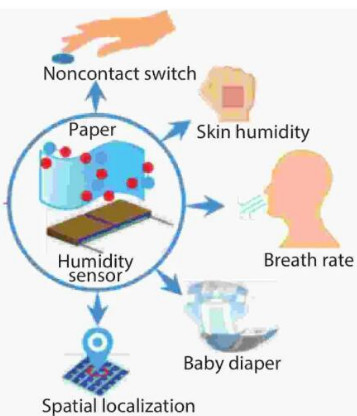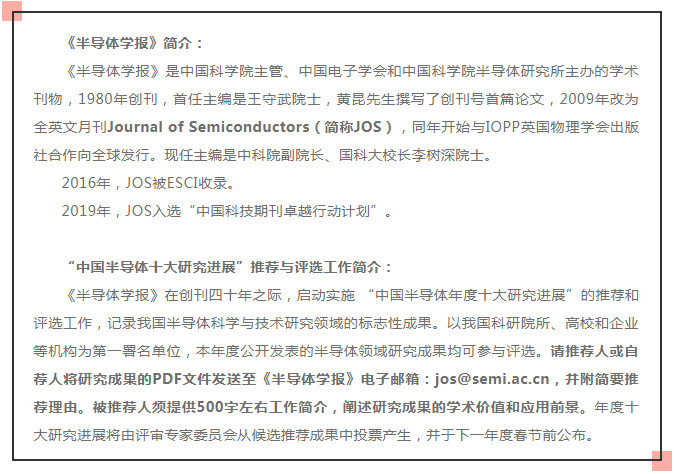各种高性能柔性湿度传感器的快速发展,拓宽了柔性电子在物联网中新的应用范围,极具发展前景,受到了越来越多的关注。近日,同济大学材料科学与工程学院黄佳教授在《Journal of Semiconductors》上撰写了文章《Recent advancements in flexible humidity sensors》,介绍了柔性湿度传感器件的意义,着重介绍并分析了在柔性湿度传感领域中,各种湿度传感材料的最新研究进展,包括:纳米结构陶瓷、金属氧化物、碳材料、聚合物、纳米纤维素和二维材料等多类型传感材料的发展和应用,并展望了它们所面临的挑战。
Abstract
Flexible electronics are attracting widespread attention due to their potential applications in wearable health monitoring and care systems[1], holding great promise in the internet of things (IoT), a fundamental concept in which devices and objects can be interconnected to form extensive networks[2]. Especially, the rapid developments of various flexible humidity sensors have broadened the scope of flexible electronics for novel applications in the IoT, such as noncontact and real-time sensation, electronic skin (e-skin), telemedicine monitoring, and wearable electronic systems (Fig. 1)[2–4].

Figure1. (Color online) Flexible humidity sensors have broadened the scope of flexible electronics for new applications in the IoT, such as non-contact control and real-time monitoring.
Recently, tremendous efforts have been devoted to improve the sensitivity, selectivity, response/recovery speed and stability of humidity sensors[5], and thus various active sensing materials and fabrication methods have been well exploited for high performance humidity sensing materials, including nanostructured ceramics, metal oxides, carbon materials, polymers, nanocellulose, and two-dimensional (2D) materials[1].
1. Nanostructured ceramics and metal oxides
Most commercially available humidity sensors are based on ceramics and metal oxides. Despite the low price, great thermal properties, mechanical strength and rapid response of ceramic based humidity sensors, issues regarding aging, rigidity and large hysteresis limit their properties such as long-term operation, flexibility and high accuracy[6, 7]. Also, temperature compensation is often required for both ceramics and metal oxides based humidity sensors. This problem can be solved by finding out new sensing materials and fabrication methods. Nanostructured ceramics and metal oxides are interesting candidates to address this problem. Dubourg et al. reported a screen-printing process for the deposition of the sensitive material, which was based on TiO2 nanoparticles, and the humidity sensor showed good overall sensing performance[8]. Recently, Shen's group reported a high performance flexible and transparent humidity sensor based on MoO3 nanosheets with a low-cost and easily manufactured process. The sensor exhibited ultrahigh sensitivity, fast response, and great stability as well as corresponding sensor arrays for practical applications in health-related moisture monitoring and multifunctional noncontact human–computer intelligence terminals. Such high sensing performance derived from the surface adsorption phenomenon of MoO3 and the formation of H2O layers for protons to transfer from one water molecule to another, leading to a significant decrease in resistance[3].
2. Carbon materials
Carbon materials have gained widespread attention owning to their combined superiorities such as diversified synthesis approaches, good electrical conductivity, intrinsic and structural flexibility, light weight, high chemical and thermal stability, as well as the ease of chemical functionalization[9]. Carbon nanotubes (CNTs) and graphene oxide/reduced graphene oxide (GO/rGO) are the main carbon materials used as sensing materials for flexible humidity sensors[5]. However, some of the GO based sensors have been made by complex and costly fabrication techniques, such as etching or layer-by-layer deposition. Worse still, the preparation of GO requires toxic oxidizing chemicals, such as sodium nitrate, potassium permanganate, and sulfuric acid[10]. To solve the first problem, Vasiljevixc et al. reported an ink-jet printing technology with interdigitated electrodes on a flexible substrate and GO based sensing layer, which achieved very large variation of response and realized cost-effectiveness[11]. Furthermore, Zhao et al. prepared a flexible temperature and humidity sensor (FTHS) from graphene woven fabrics (GWFs) prepared by chemical vapor deposition (CVD). It was fabricated through an environmentally friendly process which was also easy to operate[10].
Generally, because carbon materials based humidity sensors are working based on the interaction between water molecules and oxygenic functional groups on the carbon materials, they inevitably exhibit relatively low response and recovery speed. However, combing one kind of carbon materials with other sensing materials or exploring new mechanisms can be feasible strategies to improve their sensing performance[1]. Wu et al. pioneered the fabrication of a carbon nanocoil (CNC) based, highly sensitive, and ultrafast humidity sensor on a flexible substrate, and CNC is a mixture of amorphous, polycrystalline, and helical structure of sp2 grains and sp3 amorphous hybridized carbon atoms[12].
3. Polymers
Nowadays, polymer-based sensitive films possessing high affinity for water from inherent hydrophilic functional groups are viewed as a feasible potential used in humidity sensors, and the low-cost process, high mechanical stability, and flexibility are important for future applications in wearable devices[7]. Li et al. reported a highly flexible porous ionic membrane (PIM) based humidity sensor fabricated from a polyvinyl alcohol/KOH polymer gel electrolyte, showing a well-defined 3D porous structure[4]. Park et al. proposed a suitable hydrophilic polytetrafluoroethylene (H-PTFE) based flexible humidity sensor integrated with readout circuitry, wireless communication, and a mobile battery[6].
4. Nanocellulose
Nanocellulose, a biodegradable material originating from cellulose fibers, is a promising humidity sensing material due to the massive hydroxyl groups existing in the molecular chains. It interacts with water molecules by hydrogen bonding[13]. Nanocellulose has attracted increasing scientific researches and commercial interests recently in flexible devices because of their advantages such as natural abundance, light weight, facile fabrication, specific structural properties, environmental protection, and nontoxicity over their counterparts. Zhu et al. developed a flexible cellulose nanofiber/carbon nanotube (NFC/CNT) humidity sensor with high sensitivity performance via fast vacuum filtration[13]. However, this sensor still contains carbon materials. One of the noteworthy limitations of complete cellulose based sensors is that the electrodes are prone to cracking if the cellulose paper is folded[14]. Thus, choosing a suitable electrode material to enhance the flexibility of the paper-based sensors is challenging and desired. Duan et al. developed a multifunctional humidity sensor based on cellulose paper and flexible conductive adhesive tape electrodes, exhibiting good overall humidity sensing performance (Fig. 2)[14].

Figure 2. (Color online) A paper-based humidity sensor with multifunctional applications for breath rate, baby diaper wetting, noncontact switch, skin humidity, and spatial localization monitoring.
5. 2D materials
Recently, 2D materials have received wide attention due to their various structures, special physical and chemical properties, relatively low cost and prominent electronic properties. With almost all the atoms exposed, the charge carrier is highly sensitive to water molecules. Besides, owing to the Van Der Waals gaps between surface layers, the properties can be regulated by controlling the number of layers. Also, they have great adhesion to many flexible substrates[15]. Feng et al. found out that peeled off TaS2 nanosheets have high humidity sensing performance[2]. Jenjeti et al. demonstrated the ability of few-layer NiPS3 nanosheets for humidity sensing and the flexible device exhibited high overall sensing performance[16]. However, the high operating gate voltage and complex fabrication process were necessary in recently reported humidity sensors based on 2D-MoS2 field effect transistors, thus increasing power consumption and preparation cost[17].
In conclusion, flexible humidity sensors have developed rapidly and achieved increasing attention as a promising platform for advanced IoT applications. Despite the great advances in various flexible humidity sensors, several challenges should be further addressed in the future such as novel sensing materials, facile and low-cost fabrication methods, environment friendly preparation process, and system-level integration of multifunctional sensors.

黄佳
男,博士,同济大学教授、博士生导师、国家优秀青年科学基金获得者。
本科毕业于中国科学技术大学,2009年在美国约翰霍普金斯大学获得博士学位,长期研究有机晶体管及其在多类型传感器中的应用。以第一作者和通信作者发表SCI论文50多篇,获得中国和美国发明专利授权5项,主编英文专著1本,章节2章。
点击阅读黄佳教授文章:
Recent advancements in flexible humidity sensors
Yan Wang, Jia Huang
J. Semicond. 2020, 41(4): 040401
doi: 10.1088/1674-4926/41/4/040401
Full text
“柔性材料与结构”专刊
《半导体学报》组织了一期“柔性材料与结构”专刊,并邀请复旦大学梅永丰教授、美国加州理工学院高伟助理教授、美国东北大学方辉助理教授、电子科技大学林媛教授和中科院半导体研究所沈国震研究员共同担任特约编辑。该专刊已于2020年第4期正式出版并可在线阅读,欢迎关注。
专刊详情请见:半导体学报2020年第4期——柔性材料与结构专刊


